 Tu Van village in Thuong Tin district, Hanoi is famous for making national flags. (Photo: Hoai Nam/Vietnam+)
Tu Van village in Thuong Tin district, Hanoi is famous for making national flags. (Photo: Hoai Nam/Vietnam+) Hanoi (VNA) - Tu Van village in Hanoi’s outlying district of Thuong Tin is famous for making national flags.
Located 30km south of Hanoi, Tu Van village in Hanoi’s outlying district of Thuong Tin is famous for embroidery and weaving. It has made millions of national flags for Vietnam’s state events.
On September 2, 1945, tens of thousands of red flags with a gold star blanketed Ba Dinh Square where President Ho Chi Minh read the Declaration of Independence. Most were made by Tu Van villagers.
According to village elders, Tu Van village has been famous since the 16th century for embroidery and weaving. At that time, many of the villagers opened shops in Hanoi to sell their products. Before the general uprising in August, 1945, craftsmen were asked to make national flags, and many were employed by the Co Do (Red Flag) co-operative in Hanoi’s Hang Bong Street to make flags. This historic moment marked the establishment of Vietnam’s garment industry in Tu Van village.
The fabric used to make national flags is muslin from La Khe in Hanoi’s outlying district of Ha Dong. Other parts of the flag come from Trieu Khuc village.
Nguyen Van Phuc, the owner of a sewing workshop in Tu Van, said: “The village has 10 families engaged in flag production. Some specialize in embroidery. Some tailor national flags for new academic years, National Day celebrations, banners, and posters for major festivals and holidays, and for cheering on the Vietnamese national football team. I have followed my father’s craft. In the past, it took a long time to tailor a flag because they were all hand-made. Sometimes we couldn’t keep up with demand. Now the production process has been automated and programmed so accuracy and productivity are very high.”
Although making national flags doesn’t require much skill, the tailors need to be meticulous in their work to make sure each flag accords with the State’s regulations. Each step requires thorough attention.
Phuc said: “Many State agencies have ordered national flags made by my family. I was invited to make a 54m2 flag to be hung on the Lung Cu flag pole in Vietnam’s northernmost province of Ha Giang. The number 54 represents Vietnam’s 54 ethnic groups. It had to be beautiful and durable, because it is hung on a hill where the wind is very strong. I am a member of the village’s Craft Association, where people can share their professional experience with each other. We are proud of our products, which are as beautiful as the flags from other countries.”
 Although making national flags doesn’t require much skill, the tailors need to be meticulous in their work. (Photo: Hoai Nam/Vietnam+)
Although making national flags doesn’t require much skill, the tailors need to be meticulous in their work. (Photo: Hoai Nam/Vietnam+) National flags made by Tu Van villagers are sold in shops throughout Vietnam.
Ahead of the General Uprising on August 19, 1945, local craftsmen were asked to make national flags, with this historic moment marking the establishment of the national flag-making craft in Tu Van Village.
With the development of the market economy, many households in Tu Van Village have switched from traditional embroidery to specialising in making flags, panels and banners.
Therefore, all stages of making national flags from choosing fabrics, operating machines, printing, embroidering and sewing have been implemented urgently to meet high demand.
A complete national flag involves dozens of steps that do not require much skill, but the tailors need to be meticulous in their work to ensure each flag complies with regulatory requirements.
According to experienced tailors, the steps of printing, placing and embroidering the five-pointed star on the cloth are the most important. For them, the national flag represents the soul of the nation so the step is performed with high concentration by skilled tailors.
Whether the flag is tens of square metres large or as small as a hand palm, the five-pointed yellow star must be placed in a solemn position with the most harmonious proportion.
"We have to work with enthusiasm, maximum ability and technique to make the most beautiful flags," said Nguyen Van Phuc whose family has been in the trade for three generations./.






















